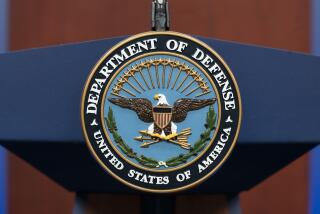Pentagon Wary of Risky Bosnia Air Raids
- Share via
WASHINGTON — The United States and its NATO allies have virtually completed military planning for air strikes in Bosnia-Herzegovina, but the Pentagon remains leery of such a move because of the serious risks involved, U.S. officials said Monday.
Defense Secretary William J. Perry confirmed that air strikes are “among the options” being considered by the North Atlantic Treaty Organization. But he added, “We’re trying to . . . minimize the problems and the limitations.”
The Pentagon, acting on a request from the White House, drew up a full-fledged mission plan in August, defense analysts said. It included a list of aircraft and crews that would be needed and a wide choice of targets, depending on the military objective.
Those targets range from Serbian troops and artillery now surrounding the Bosnian capital of Sarajevo to Serb-controlled artillery bases, ammunition dumps, command centers and logistics depots. U.S. planners have coordinates for each and update them constantly.
The allies already have hundreds of warplanes at the ready--most of them equipped with nighttime radar--on the aircraft carrier America and at air bases in Italy and Turkey. The Army also has air controllers at the ready to help locate Serbian artillery.
U.S. officials said that the bombers could be ready to go “within an hour” of any decision by NATO leaders to proceed with the attacks. The NATO Advisory Committee, a high-level planning panel, is slated to meet in Brussels on Wednesday.
But Robert W. Gaskin, a former Pentagon war planner, said that any air operation would entail an estimated two weeks of grueling, round-the-clock bombing with conventional weapons--a far cry from the precision, down-the-chimney bombing seen during the Persian Gulf War.
Moreover, Gaskin and other military experts warned that air strikes would pose some serious risks, in terms of both the hazard to Bosnian civilians and the threat of drawing the allies into a protracted war.
Among the considerations:
* It can be difficult to determine which of the warring factions--the Serbs, Croats or Muslims--is manning a specific artillery post. The forces are in close proximity and, as Saturday’s shelling of a crowded marketplace in Sarajevo showed, it can be difficult to tell who did the firing.
* The risk of killing civilians would probably be high. Many of the Serbian mortars are hidden in civilian homes in the Sarajevo suburbs. Attacking them would destroy the homes and probably harm civilians as well.
* Despite the sophistication of the allied aircraft, weather and terrain would pose a major problem. The mountainous landscape and winter’s heavy fog spell danger to pilots and make locating targets extremely difficult.
* Attacking Serbian positions almost certainly would bring retaliation against U.N. peacekeeping troops. The United Nations now oversees 28,000 mostly British, French, Spanish and Canadian troops in Bosnia. U.S. pilots also would be vulnerable to shoulder-fired missiles.
* The question of what the allies would do after the initial round of attacks ended remains unanswered. If the Serbs chose to continue their fight, the West could find itself locked in a protracted war with heavy casualties.
Military experts said that the Pentagon might want to consider some steps before beginning air strikes. It could, for example, bring in artillery detectors that can pinpoint guns and mortars within seconds after they have been fired.
NATO planners also must improve their command-and-control capabilities in Bosnia. The allies need a fourth command center in the area to coordinate their attacks more effectively, officials said.
Gaskin, now a vice president of Business Executives for National Security, a Washington research group, said that NATO forces could “shut the place down” within two or three weeks but added: “What would we do after that? It’s a question to ponder.”
More to Read
Sign up for Essential California
The most important California stories and recommendations in your inbox every morning.
You may occasionally receive promotional content from the Los Angeles Times.










